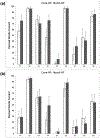What to Do When Cochlear Implant Users Plateau in Performance: a Pilot Study of Clinician-guided Aural Rehabilitation
- PMID: 30199497
- PMCID: PMC6132264
- DOI: 10.1097/MAO.0000000000001964
What to Do When Cochlear Implant Users Plateau in Performance: a Pilot Study of Clinician-guided Aural Rehabilitation
Abstract
Hypothesis: For experienced adult cochlear implant (CI) users who have reached a plateau in performance, a clinician-guided aural rehabilitation (CGAR) approach can improve speech recognition and hearing-related quality of life (QOL).
Background: A substantial number of CI users do not reach optimal performance in terms of speech recognition ability and/or personal communication goals. Although self-guided computerized auditory training programs have grown in popularity, compliance and efficacy for these programs are poor. We propose that CGAR can improve speech recognition and hearing-related QOL in experienced CI users.
Methods: Twelve adult CI users were enrolled in an 8-week CGAR program guided by a speech-language pathologist and audiologist. Nine patients completed the program along with pre-AR and immediate post-AR testing of speech recognition (AzBio sentences in quiet and in multitalker babble, Consonant-Nucleus-Consonant words in quiet), QOL (Nijmegen Cochlear Implant Questionnaire, Hearing Handicap Inventory for Adults/Elderly, and Speech, Spatial and Qualities of Hearing Scale), and neurocognitive functioning (working memory capacity, information-processing speed, inhibitory control, speed of lexical/phonological access, and nonverbal reasoning). Pilot data for these nine patients are presented.
Results: From pre-CGAR to post-CGAR, group mean improvements in word recognition were found. Improvements were also demonstrated on some composite and subscale measures of QOL. Patients who demonstrated improvements in word recognition were those who performed most poorly at baseline.
Conclusions: CGAR represents a potentially efficacious approach to improving speech recognition and QOL for experienced CI users. Limitations and considerations in implementing and studying aural rehabilitation approaches are discussed.
Conflict of interest statement
Conflicts of Interest: The authors receive grant funding support from Cochlear Americas for a related investigator-initiated study of clinician-guided aural rehabilitation in newly implanted adult cochlear implant patients.
Figures



References
-
- Firszt JB, Holden LK, Skinner MW, et al. Recognition of speech presented at soft to loud levels by adult cochlear implant recipients of three cochlear implant systems. Ear Hear 2004;25(4):375–387. - PubMed
-
- Gifford RH, Shallop JK, Peterson AM. Speech recognition materials and ceiling effects: considerations for cochlear implant programs. Audiol Neurotol 2008;13:193–205. - PubMed
-
- Hast A, Schlücker L, Digeser F, Liebscher T, Hoppe U. Speech perception of elderly cochlear implant users under different noise conditions. Otol Neurotol 2015;36(10):1638–43. - PubMed
-
- Lenarz M, Sönmez H, Joseph G, Büchner A, Lenarz T. Long-term performance of cochlear implants in postlingually deafened adults. Otolaryng Head Neck 2012;147(1)112–8. - PubMed
Publication types
MeSH terms
Grants and funding
LinkOut - more resources
Full Text Sources
Other Literature Sources
Research Materials

